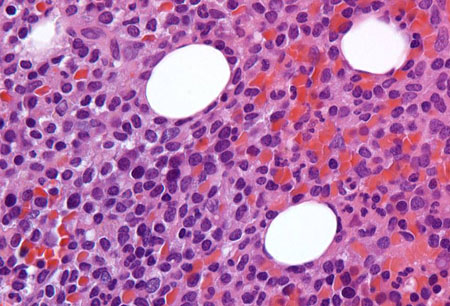Summary
Definition
History and exam
Key diagnostic factors
- presence of risk factors
- abdominal fullness or discomfort
- splenomegaly
Other diagnostic factors
- weakness and fatigue
- unexplained weight loss
- bruising and bleeding
- pallor
- recurrent infections
- hepatomegaly
- lymphadenopathy
- neurological findings
- associated systemic immunological disorders
Risk factors
- middle age
- male sex
- white ancestry
- western hemisphere location
- environmental exposures
- genetic predisposition
- Epstein-Barr virus
- infectious mononucleosis
Diagnostic investigations
1st investigations to order
- FBC with differential
- peripheral blood smear
- bone marrow trephine biopsy and aspiration (morphology assessment)
- immunophenotyping (immunohistochemistry or flow cytometry)
- comprehensive metabolic panel
- serum lactate dehydrogenase (LDH)
- viral serology for hepatitis B and C
Investigations to consider
- molecular analysis (for BRAF V600E mutation or IGHV4-34 rearrangement)
- CT chest, abdomen, and pelvis
Treatment algorithm
no indication(s) for treatment
indication(s) for treatment present: without splenic rupture or massive splenomegaly or marked thrombocytopenia precluding chemotherapy
indication(s) for treatment present: with massive symptomatic splenomegaly or splenic rupture or marked thrombocytopenia precluding chemotherapy
early relapse (<2 years) or refractory disease
late relapse (≥2 years)
Contributors
Authors
Ambuj Kumar, MD, MPH
Professor
USF Health Office of Research
Department of Internal Medicine, College of Medicine
Moffitt Cancer Center & Research Institute, Department of Health Outcomes & Behavior
University of South Florida
Tampa
FL
Disclosures
AK declares that he has no competing interests.
Mohamed A. Kharfan-Dabaja, MD, MBA, FACP
Professor
Division of Hematology-Oncology
Blood and Marrow Transplantation Program
Mayo Clinic
Jacksonville
FL
Disclosures
MKD declares that he has no competing interests.
Acknowledgements
Dr Ambuj Kumar and Dr Mohamed Kharfan-Dabaja would like to gratefully acknowledge Dr Benjamin Djulbegovic, a previous contributor to this topic.
Disclosures
BD declares that he has no competing interests.
Peer reviewers
Daniel Catovsky, MD, FRCP, FRCPath, DSc, FMedSc
Consultant Haemato-Oncologist
Section of Haemato-Oncology
Brookes Lawley Institute of Cancer
Sutton
UK
Disclosures
DC declares that he has no competing interests.
Roger Lyons, MD
Clinical Professor of Medicine
University of Texas Health Science Center San Antonio
San Antonio
TX
Disclosures
RL declares that he has no competing interests.
Rebecca Connor, MD
Chief Fellow
Section of Hematology and Oncology
Department of Internal Medicine
Wake Forest University Baptist Medical Center
Winston-Salem
NC
Disclosures
RC declares that she has no competing interests.
Claire Dearden, BSc, MD, FRCP, FRCPath
Consultant Haematologist
The Royal Marsden Hospital
Sutton
Surrey
UK
Disclosures
CD declares that she has no competing interests.
References
Key articles
Parry-Jones N, Joshi A, Forconi F, et al. Guideline for diagnosis and management of hairy cell leukaemia (HCL) and hairy cell variant (HCL-V). Br J Haematol. 2020 Dec;191(5):730-7.Full text Abstract
Troussard X, Maître E, Paillassa J. Hairy cell leukemia 2024: update on diagnosis, risk-stratification, and treatment - annual updates in hematological malignancies. Am J Hematol. 2024 Apr;99(4):679-96.Full text Abstract
Grever MR, Abdel-Wahab O, Andritsos LA, et al. Consensus guidelines for the diagnosis and management of patients with classic hairy cell leukemia. Blood. 2017 Feb 2;129(5):553-60.Full text Abstract
National Comprehensive Cancer Network. NCCN clinical practice guidelines in oncology: hairy cell leukemia [internet publication].Full text
Robak T, Matutes E, Catovsky D, et al. Hairy cell leukaemia: ESMO clinical practice guidelines for diagnosis, treatment and follow-up. Ann Oncol. 2015 Sep;26(suppl 5):v100-7.Full text Abstract
Troussard X, Maître E, Cornet E. Hairy cell leukemia 2022: update on diagnosis, risk-stratification, and treatment. Am J Hematol. 2022 Feb 1;97(2):226-36.Full text Abstract
Reference articles
A full list of sources referenced in this topic is available to users with access to all of BMJ Best Practice.

Differentials
- Chronic lymphocytic leukaemia (CLL)
- Mantle cell lymphoma
- Pro-lymphocytic leukaemia
More DifferentialsGuidelines
- NCCN clinical practice guidelines in oncology: hairy cell leukemia
- Guideline for diagnosis and management of hairy cell leukaemia (HCL) and hairy cell variant (HCL-V)
More GuidelinesLog in or subscribe to access all of BMJ Best Practice
Use of this content is subject to our disclaimer
